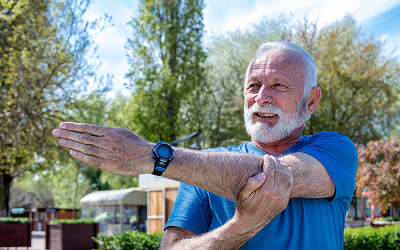Introduction: The Shift to Regenerative Medicine for Joints
Joint pain that persistent ache in your knee, the stiffness in your hip, or the grinding in your shoulder—impacts millions globally. This common reality significantly erodes quality of life, turning simple acts like walking or lifting into painful struggles.
Traditional Approaches: Managing Symptoms, Not Causes
Historically, common treatments for joint pain focused only on managing symptoms. These included: Medications like over-the-counter and prescription NSAIDs reduce pain and swelling.
Physical Therapy works to strengthen the surrounding muscles for better joint support. Corticosteroid Injections offer powerful, temporary anti-inflammatory relief, but repeated use carries risks. Finally, Surgery, such as arthroscopy or total joint replacement, represents the final, irreversible option.
Although these methods offer relief, they often fail to address the root problem: the progressive deterioration of cartilage and underlying tissue.
This realization, therefore, drove a global shift toward regenerative medicine. Here, the focus moves from masking pain to promoting genuine tissue repair.
Introducing Stem Cell Therapy for Joint Pain
Stem Cell Therapy for Joint Pain is now at the forefront of this revolution. It is an innovative, non-surgical treatment that harnesses the body’s own potential to heal.
Physicians inject powerful, specialized cells directly into the damaged joint. This action encourages tissue repair and simultaneously reduces the chronic inflammation fueling the pain cycle.
This growing field presents patients with choices. The two most discussed sources of these powerful regenerative cells are umbilical cord tissue (allogeneic) and the patient’s own bone marrow (autologous).
Consequently, understanding the nuances between these two options becomes crucial for making an informed decision about your future joint health. This comprehensive guide will compare the two leading forms of Stem Cell Therapy for Joint Pain.
What is Stem Cell Therapy for Joint Pain?
To appreciate the distinction between the cell sources, we must first understand the remarkable nature of stem cells themselves.
General Description of Stem Cells and Their Regenerative Properties
People often call stem cells the body’s “repair crew.” Unlike specialized cells, stem cells are undifferentiated. This means they have the capacity to do two things:
First, they Replicate, dividing repeatedly to replenish their own population.
Second, they Differentiate, transforming into various specialized cell types needed for repair, such as chondrocytes (cartilage), osteoblasts (bone), or tenocytes (tendon). The type most pertinent to orthopedic and joint healing are Mesenchymal Stem Cells (MSCs).
Benefits of Joint Pain Treatment with Stem Cells
Patients seek Joint Pain Treatment with Stem Cells because they look for a sustainable, biological solution that avoids surgery. The key benefits include:
- Modulation of the Immune Response: MSCs release powerful anti-inflammatory molecules. This effectively calms the hostile environment within an arthritic joint.
- Tissue Signaling: They secrete growth factors and proteins. These stimulate the existing native cells in the joint to begin repairing damaged cartilage and other soft tissues.
- Pain Relief and Functional Improvement: By reducing inflammation and promoting regeneration, Stem Cell Therapy for Joint Pain can lead to significant, long-term pain reduction and movement restoration.
What Are Umbilical Stem Cells? (Allogeneic)
Umbilical stem cell therapy utilizes allogeneic (donor) cells. Doctors specifically harvest these cells from the umbilical cord tissue.
Overview of Umbilical Stem Cells, Their Source, and Composition
Source and Composition: Physicians ethically and safely derive these cells from the Wharton’s Jelly (a gelatinous substance inside the umbilical cord) or amniotic fluid. This harvest occurs following a healthy, full-term delivery.
Allogeneic Nature: Crucially, they are immunologically privileged. This means they rarely provoke an immune response in the recipient, eliminating the need for tissue matching or rejection concerns.
Testing and Safety: The donor tissue and the final product undergo rigorous screening and testing for infectious diseases and purity. This process ensures a safe, ready-to-use product.
How Umbilical Stem Cells Work to Treat Joint Pain
Umbilical Stem Cells for Joint Pain offer a high-quantity treatment. Their mechanism of action is primarily through paracrine signaling.
Growth Factor Powerhouse: They release a dense “soup” of potent growth factors, cytokines, and exosomes (tiny biological packages). These deliver repair instructions to the patient’s own cells. This powerful signaling essentially wakes up the local repair cells and dictates where and how to heal.
Targeted Inflammation Control: Their strong anti-inflammatory properties can quickly subdue pain and swelling, thus creating an optimal environment for regeneration.
High Dosage: Clinics can use a significantly higher, standardized number of live cells per injection compared to autologous sources. This maximized dosage makes Stem Cell Therapy for Joint Pain using umbilical tissue a powerful option.
What Are Bone Marrow Stem Cells? (Autologous)
Bone marrow stem cells represent the longest-established and most common form of autologous (self-sourced) Stem Cell Therapy for Joint Pain.
Overview of Bone Marrow Stem Cells, Their Source, and Composition
Source and Composition: Doctors obtain these cells directly from the patient’s own body, usually from the pelvic bone. They use a procedure called a Bone Marrow Aspirate.
Then, centrifugation concentrates the aspirated fluid into a product known as Bone Marrow Aspirate Concentrate (BMAC).
Autologous Advantage: Because the source is the patient, there is virtually zero risk of immune rejection or disease transmission from a donor. The body perfectly recognizes its own cells.
How Bone Marrow Stem Cells Work to Treat Joint Pain
The efficacy of Bone Marrow Stem Cells lies in the synergistic effect of all the components within the BMAC. When doctors inject the BMAC into the joint (a form of Stem Cell Injections for Knee Pain, hip, or shoulder), the cells and factors perform three key actions:
- Natural Repair Delivery: They deliver the body’s natural, native healing components directly to the site of damage. This promotes a localized, concentrated repair effort.
- Differentiation Potential: The MSCs within the BMAC can potentially differentiate into new cartilage cells. This helps to rebuild the deteriorated joint surface.
- Matrix Stabilization: Furthermore, the growth factors aid in stabilizing the surrounding extracellular matrix. This is vital for long-term joint health. This tried-and-true method of Stem Cell Therapy for Joint Pain has decades of orthopedic use.
Comparing Umbilical vs. Bone Marrow Stem Cells in Detail
The decision between the two regenerative options, allogeneic umbilical cells versus autologous bone marrow cells, is critical. Therefore, you must carefully compare them across several key areas.
Effectiveness: Potency, Quantity, and Clinical Efficacy
Umbilical cells often have a distinct advantage when we look at cell potency. They are “young” and highly potent. They remain unaffected by the patient’s age, health, or lifestyle factors.
Consequently, the regenerative ability of the treatment decreases if a patient is older, especially past their prime, because their native Bone Marrow Stem Cells become less potent and numerous.
Regarding cell quantity, laboratories can expand umbilical products. This guarantees a consistently high, therapeutic cell dose every time.
The quantity of bone marrow cells, conversely, is variable. It remains limited to what doctors can safely and effectively aspirate from the patient during the procedure.
This ability to deliver a high, consistent cell count makes Umbilical Stem Cells for Joint Pain a strong choice. It works well for more severe or chronic conditions where maximum regenerative signaling is desired.
While bone marrow therapy has a proven clinical track record, its effectiveness, however, depends more on the patient’s biological youth and health.
Many studies suggest that both are effective for functional improvement. Nevertheless, umbilical-derived cells may show superior efficacy in promoting cartilage regeneration itself.
Harvesting Process and Patient Comfort
The required procedure represents one of the most immediate differences. Umbilical Stem Cells involve no harvesting procedure for the patient. Doctors simply thaw and inject the final product. Recovery focuses solely on the joint injection site.
Bone Marrow Stem Cells, however, require a prior, invasive aspiration procedure. This procedure involves administering local anesthesia or sedation.
Doctors use a needle to draw marrow from the pelvic bone. This harvesting can become the primary source of procedural pain for the patient. Therefore, the therapy and recovery from Stem Cell Therapy for Joint Pain using bone marrow must account for both the joint injection and the healing of the harvest site.
Risk Factors and Safety Profile
Both forms of Stem Cell Therapy for Joint Pain generally have an excellent safety profile. However, their risks differ based on their source.
With Bone Marrow Stem Cells, safety is rooted in their autologous nature. This means patients face virtually zero risk of immune rejection or disease transmission. The primary risks remain minor: pain, bruising, or a low risk of infection at the harvest site.
For Umbilical Stem Cells, the risk of immune reaction is extremely low. This is due to the immunologically privileged nature of the tissue.
The crucial risk lies in the quality and testing of the product. Patients must paramountly seek treatment only from clinics. These clinics must utilize products from FDA-registered and compliant laboratories that rigorously screen donors and test the final cellular product for safety and purity.
While rare, infections linked to improperly processed allogeneic products have been reported. This outcome truly emphasizes the need for due diligence.
Recovery Time from the Procedure
Recovery from Umbilical Stem Cells is typically swifter. It often involves just a day or two of rest, as the patient only needs to recover from the injection itself.
Recovery from Bone Marrow Stem Cells is slightly prolonged. Patients must recover from two sites: the injection site and the bone marrow aspiration site. This second site can remain sore or tender for three to seven days. This means the overall downtime can be a bit longer with the autologous option.
Therefore, the umbilical option appeals more to those needing a rapid return to light activity. However, both procedures emphasize a guided rehabilitation protocol for weeks afterward. This protocol maximizes the regenerative outcome of the Stem Cell Therapy for Joint Pain.
Who Should Consider Stem Cell Therapy for Joint Pain?
Regenerative medicine is not a one-size-fits-all solution. Instead, it’s an ideal option for individuals with chronic joint issues.
These patients look for a bridge between conservative care and invasive surgery. This group includes those with mild-to-moderate osteoarthritis, chronic tendon injuries, or ligament damage.
Ideal Candidates for Umbilical Stem Cells for Joint Pain
You may be an ideal candidate for Umbilical Stem Cells for Joint Pain if:
- You are over the age of 55: You need the superior potency and high cell count of young, healthy donor cells. These cells help overcome the natural regenerative decline associated with age.
- You have severe or multi-joint arthritis: The high dosage and strong signaling power may prove necessary for more significant tissue repair challenges.
- You prioritize comfort and fast recovery: You want to avoid the procedural discomfort and soreness associated with the bone marrow aspiration.
- You require a standardized, high-dose product for consistent therapeutic potential.
Ideal Candidates for Bone Marrow Stem Cell Therapy
You may be an ideal candidate for therapy utilizing your own Bone Marrow Stem Cells if:
- You are under the age of 50 and are generally healthy: Your autologous cells are still highly potent and numerous enough to offer significant regenerative benefit.
- You prefer an autologous procedure: You are determined to use only your own, native biological material to ensure zero risk of foreign material rejection.
- You have mild to moderate joint issues: Your condition may not require the ultra-high potency of umbilical cells, and your own cells can provide sufficient healing.
- You have a condition with a strong history of positive outcomes using BMAC, such as specific ligament tears or early-stage arthritis.
Conclusion: Choosing Your Path to Regeneration
Stem Cell Therapy for Joint Pain offers a phenomenal opportunity. It helps patients move past temporary fixes and embrace a future with improved joint function and reduced chronic pain.
Both are powerful tools in regenerative medicine. However, they are distinct treatments suited to different patient profiles.
The decision is a deeply personal one. You must weigh the superior potency and procedural ease of umbilical cells against the self-sourced safety and established methodology of bone marrow cells.
Ultimately, the most effective stem cell joint pain therapy is the one carefully matched to your unique biology, health status, and specific joint condition.
Final Recommendations for Patients Considering Stem Cell Therapy
Our strongest recommendation encourages you to approach this decision with a commitment to education and personalized medical guidance.
Seek consultation with a highly qualified, experienced regenerative medicine specialist. This doctor can review your imaging (X-rays, MRIs) and medical history.
A comprehensive evaluation will ensure you receive the most effective and appropriate stem cell joint pain therapy for your body.
The future of Regenerative medicine for joints is here, and taking the time to choose the right cell source is key to achieving your desired outcome.
Call to Action
If you are tired of living with chronic joint pain and are ready to explore the life-changing possibilities of regenerative medicine, don’t wait.
Choosing the right source for your Stem Cell Therapy for Joint Pain is the first step toward reclaiming your mobility and quality of life.
We encourage you to schedule a consultation with our regenerative medicine specialists today. We use advanced diagnostic techniques to precisely determine the optimal therapy—be it autologous or allogeneic—for your unique joint needs.
Contact us now for further inquiries and to begin the process of booking your specialized consultation.




